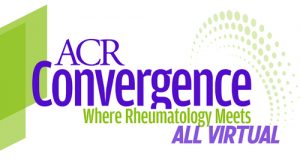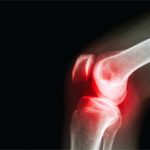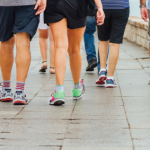The ACR recognizes this year has presented incredible challenges, but focusing on the future will help all of us move forward. Taking place Nov. 5–9, ACR Convergence 2020—the ACR’s renamed and reconceptualized annual meeting—will be a fully virtual opportunity for the global rheumatology community to come together to collaborate, innovate and learn.
The ACR Convergence program includes four 30-minute sessions that will offer brief overviews of disease states and their management, focusing on rheumatoid arthritis (RA), bone health, joint health and psoriatic arthritis. These shorter sessions, called Down & Dirty 30, will be presented in a new format designed to help pivot the conference to an online format. The sessions will provide crash courses or refreshers on select rheumatology topics with a nuts-and-bolts focus, according to Julie Schwartzman-Morris, MD, associate professor, Department of Medicine, Rheumatology, Donald and Barbara Zucker School of Medicine at Hofstra/Northwell, Hempstead, N.Y., and a member of ACR’s Annual Meeting Planning Committee.
“That’s why it’s called Down & Dirty 30,” says Dr. Schwartzman-Morris. “It’s kind of like a few bullet points for anyone who needs a refresher on treatment guidelines and if there are any new recommendations on making diagnostic decisions or diagnostic dilemmas—that’s the idea.”
Two presentations will address exercising for bone and joint health, and are well suited for conference participants new to rheumatology, as well as clinical pharmacists, trainees or research professionals who want a disease-state refresher in a concentrated block, according to session coordinators.
“Exercise is well known to positively affect and improve bone and joint health for individuals across the lifespan,” says Elizabeth Wellsandt, PT, DPT, PhD, OCS, assistant professor, Physical Therapy Education Division, University of Nebraska Medical Center (UNMC), Omaha, and a session coordinator. “Clinicians will become more confident in understanding the mechanisms of action, necessary precautions and recommended approaches of exercise to improve bone and joint health for patients with rheumatic disease.”
Down & Dirty 30: Therapeutic Exercise for Bone Health
Laura D. Bilek, PT, PhD, associate dean for research, College of Allied Health Professions, UNMC, will explore the role of exercise in a treatment plan to maximize bone health in patients with rheumatic conditions, who are likely to have decreased bone density and increased fracture risk. Dr. Bilek will discuss the use of evidence-based exercise interventions to improve bone health and decrease fracture risks. She will also cover how to modify therapeutic exercises for people at high risk for fractures and offer specific precautions people with rheumatic diseases or osteoporosis should be advised to take before beginning an exercise program.
“Resistance training is key to aging well,” says Dr. Bilek. “It helps our bones, as well as helps us maintain our function and independence.”
Lifting weights properly is one way to improve bone health for the young and middle-aged, notes Dr. Bilek. “You really need to lift a weight that you can only lift about eight to 10 times before your muscles can’t lift it anymore for it to work effectively. That’s what the research is telling us: that you have to lift the weights right,” she says.
Teach patients not to bend over or twist while lifting weights, because even in a young patient that motion can cause a fracture, says Dr. Bilek. It’s important to keep the trunk in alignment to avoid potential harm.
“That’s one of the big factors we’re going to talk about in prescribing exercise,” she says.
At the other end of the spectrum are older patients with osteoporosis who have experienced fractures, but who may benefit from exercise using light weights. These patients typically have fragile bones and the risk of harm from exercise is much higher, cautions Dr. Bilek.
“Your treatment is going to have to be very tailored,” she says. “There isn’t really a one-size-fits-all model. It depends how fragile the bones are—because it can vary—and it also depends on whether they are in the active stages of healing.”
Down & Dirty 30: Therapeutic Exercise for Joint Health
The session on therapeutic exercise for joints will be presented by Yvonne Golightly, PT, MS, PhD, an injury/musculoskeletal epidemiologist in the Department of Epidemiology, Gillings School of Global Public Health, University of North Carolina, Chapel Hill. Her experience spans more than a decade of work as an orthopedic physical therapist and osteoarthritis (OA) researcher focusing on modifiable risk factors of OA.
Dr. Golightly will describe the role and challenges of exercise in joint health among people with rheumatic and musculoskeletal diseases who may have changes in cartilage or bone. Her discussion will cover how to promote exercise and increase physical activity for patients with rheumatic diseases. She will include strategies for healthcare professionals to support the safe performance and progression of therapeutic exercise.
Some individuals with rheumatic and musculoskeletal diseases may not participate in regular exercise because they are worried that exercise will worsen their joint health and pain. Exercise has been shown to be an effective way to reduce joint pain and improve function. Moderate physical activity does not appear to harm articular cartilage, according to Dr. Golightly.
“For patients with rheumatic and musculoskeletal diseases, we want to encourage a sustained physical activity behavior change,” writes Dr. Golightly in an email. “Starting any new exercise program slowly is important for minimizing soreness and to build confidence in their ability to exercise.
“Therapeutic exercise programs include resistance training, aerobic activities (e.g., walking or cycling), balance activities and exercises aimed at maintaining or increasing range of motion. These programs should be tailored to the individual’s abilities and goals, and patient education, along with regular reassessments by the healthcare provider, can guide safe progression of the exercises.”
Down & Dirty 30: RA from Diagnosis to Treatment
Monica Richey, BSN, MSN, ANP-BC, GNP, will talk about RA and steps to advance patient care from diagnosis to treatment and beyond. A nurse practitioner with Northwell Health, New York, Ms. Richey has gained valuable insight from years of working directly with patients, including her annual, weeklong visits to South Dakota to provide much needed treatment to Native Americans.
“It really sharpens your clinical skills,” says Ms. Richey of her work at the Pine Ridge Reservation, because normal resources are limited, and patients typically don’t have access to medical specialists. “You have to trust your clinical judgment to make the diagnosis and make a long-term plan. You see that patient once, plan what’s going to happen for the whole year and leave it all in the notes so the primary care [professional] can follow your steps.”
During her ACR Convergence 2020 session, Ms. Richey plans to examine the normal evolution of RA and will likely present a case study to illustrate key stages, she says. Her talk will cover steps to take when a patient presents with symptoms, understanding X-rays, laboratory results and other diagnostic tools, a review of ACR treatment guidelines and the necessity of monitoring patient therapy.
“Monitoring is very important,” says Ms. Richey, because therapy can have side effects, such as elevated lipids, neutropenia and transaminitis. Even if a patient is stable, monitoring is needed to ensure a medication is working and to identify unwanted, unexpected or harmful effects.
With an emphasis on current treatment guidelines, the presentation will speak to the professional interests of nurses, pharmacists, new fellows just starting their careers or anyone who wants to learn more about the initial diagnosis, progression of treatment and progression of the disease itself.
Down & Dirty 30: Psoriatic Arthritis
Daniela Schwartz, MD, assistant clinical investigator at the National Institutes of Health’s (NIH) National Institute of Allergy and Infectious Diseases, will present the psoriatic arthritis session. In her work for the NIH, she investigates the regulation and roles of allergy-associated cytokines in rheumatic diseases, including psoriasis and psoriatic arthritis, according to Ann Biehl, MS, PharmD, a member of the Annual Meeting Planning Committee.
“Dr. Schwartz is a rising star [in] the NIH community,” says Ms. Biehl. “She is a fantastic teacher and collaborator.”
Psoriatic arthritis affects up to 20% of people with psoriasis and, if left untreated, can cause severe joint destruction. The condition is also less responsive to medications approved by the U.S. Food & Drug Administration than psoriatic skin disease.
This session will touch on identifying various presentations of psoriatic arthritis in patients with different types of psoriatic skin disease, says Ms. Biehl. Dr. Schwartz will wrap up with a discussion of treatment options and a review of the extra-articular comorbidities of patients with psoriatic arthritis and associated screening guidelines.
Each speaker will hold a five-minute question-and-answer period following their presentations. Here are the dates and times of all four sessions:
- Sunday, Nov. 8, 10–10:30 a.m. EST
Down & Dirty 30: Therapeutic Exercise for Bone Health - Sunday, Nov. 8, 10:45–11:15 a.m. EST
Down & Dirty 30: Therapeutic Exercise for Joint Health - Sunday, Nov. 8, 3–3:30 p.m. EST
Down & Dirty 30: Rheumatoid Arthritis from Diagnosis to Treatment - Sunday, Nov. 8, 3:45 p.m.–4:15 p.m. EST
Down & Dirty 30: Psoriatic Arthritis
Catherine Kolonko is a medical writer based in Oregon.


